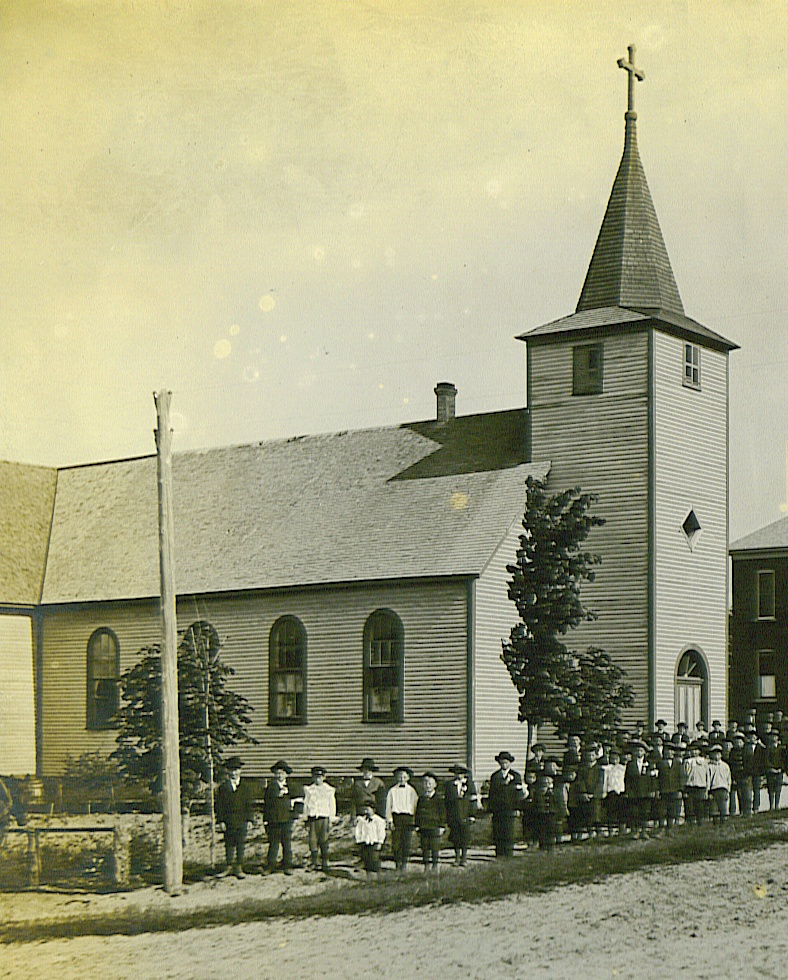
The Discovery
The bones of Sister Mary Janina (Ya-nina) were unearthed from the basement cellar of Holy Rosary Catholic church in late 1918. It had been 11 years since the nun had gone missing. Father Edward Podlaszewski was the new priest who wanted to build a stylish church on the site. He had heard rumors from Bishop Edward Kozlowski and asked the sexton, Jacob Flees, to assist him on the late fall night. With lanterns and a potato fork in hand, the pair crept to the dirt floor under the wooden clapboard structure in the November duskiness.
Father Edward had planned to construct a Roman style brick church with thirteen stained glass windows which he had ordered from Franz Xavier Zettler, a well known Vatican artist. These pieces of artwork were being carefully stored under sawdust in Munich, Germany. As World War I had just ended, it was not safe to ship them yet. The vision of this new church was Father Edward’s pride. He needed to be sure the area was clear before construction could begin. If the construction crews (or worse the parishioners) discovered a body it would be scandalous.
The lanterns dispensed an eerie glow as Jacob lifted nun’s bones into a wooden crate. He discovered the remains of a fetus cradled in Sister Janina’s skeleton. Father Edward told Jacob to secretly bury the crate under the large cross in the cemetery. Scandal was to be avoided at all costs. Jacob Flees kept his silence. He didn’t even tell his wife, Mary.
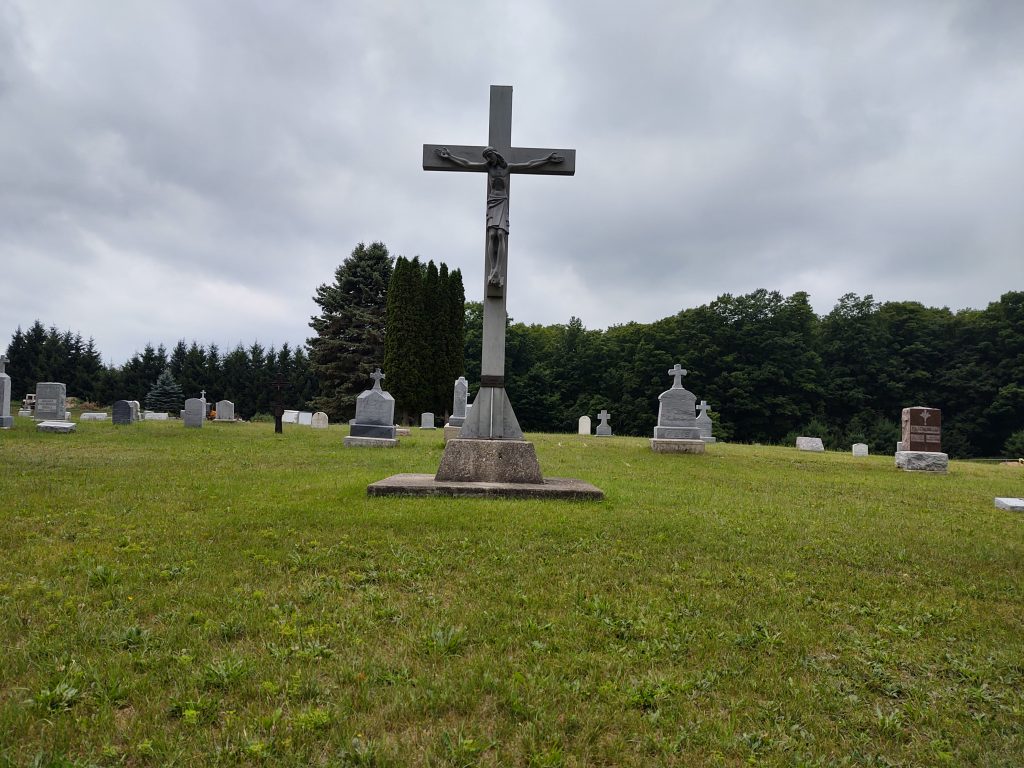
This tight knit Polish community had immigrated to the United States due to overpopulation, desire for land and enthusiastic letters from their relatives. Milwaukee, Wisconsin had been a large influx of Polish immigrants who were being racially excluded from employment and loans. So a Catholic group of had banded together and traveled across Lake Michigan from their settlement in Milwaukee to homestead in the “pinky” of lower Michigan. The Polish American Insurance Company, Polish National Alliance and the Polish Union created financial and moral support. These businesses and their Catholic faith provided the stability that the community thrived on. Their allegiance to one another was unwavering. No one would imagine upsetting their parish with unneeded worry.
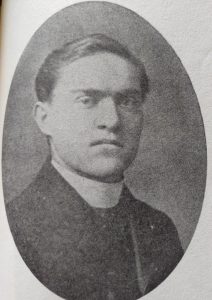
Photo from “Isadore’s Secret” by Mardi Link
However, Father Edward confided in Sister Superior Hillaria, the head teacher of the school, and Sister Gastone the assistant Felician nun.
A week or so later Father Edward was called to the Miller home. Martha, the teenage daughter who worked as a housekeeper at Holy Rosary church, was pregnant. Stubbornly Martha wouldn’t reveal with whom she had shared relations. Father Edward agreed to keep this quiet and take Martha to St. Joseph’s Hospital in Ann Arbor where she could stay until the baby was born and given up for adoption. He promised to transport her back home after six weeks.
On January 24, 1919 on Martha’s return trip with Father Edward, he confideded about Sister Janina being found. Martha remembered hearing about the nun who had liked to sing while she walked through the woods. Sister Janina’s outgoing personality was unusual for a lady of faith. When the nun had disappeared many had thought Sister had secretly left the church. Martha had heard these rumors and assumed that Sister hadn’t felt comfortable in their close knit, conservative community.
After spending six weeks on her own, giving birth to her baby and releasing her to an unknown family Martha felt more confident in herself and soon confessed to her dad, Joseph Miller. Martha finally admitted that Father Edward was the father of her baby. Martha continued and told her dad about Sister Janina’s bones being found under the church. Joseph Miller immediately met with the sheriff.
Father Edward was sent away to St. Bonaventure Monastery in Detroit where he would face his trial in front of Catholic leaders. As punishment, he was sent to a small church in the foothills of the Great Smoky Mountains in Kentucky for THIRTY days. Then, he was moved to Warszawa district in Cleveland, Ohio to work under Father Marion J. Orzechowski and serve the parish of Immaculate Heart of Mary.
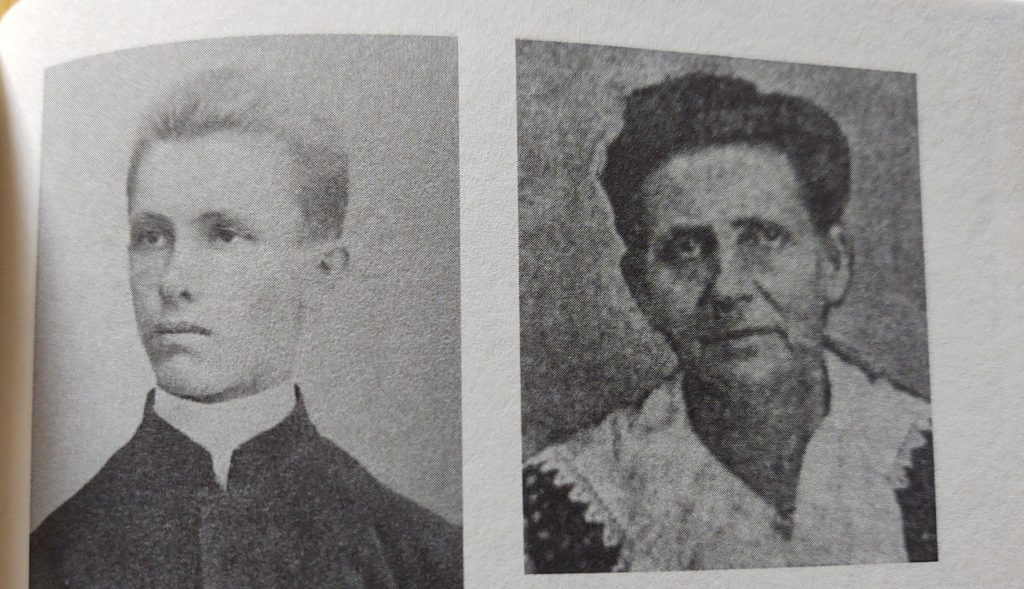
Stanislawa “Stella” Lipczynska was the housekeeper
Photo Credit: “Isasore’s Secret” by Mardi Link
Father Andrew Bieniawski and his housekeeper, Stanislawa “Stella” Lipczynska, were brought north from Manistee for questioning. (A four hour drive) The cohort pair had served at Holy Rosary along with Sister Janina, Sister Angelina and Sister Josephine. Father Andrew had been reassigned after Sister Janina’s disappearance in 1907. Stella had decided to follow Father Andrew to his new church and continue her employment.
The Disappearance
It was Friday, August 23, 1907, baking day, in the village of Isadore. Settlers had a job assigned for each day of the week: washing, ironing, mending, churning, baking and cleaning. Father Andrew, his sister, Susan, and Gruba, the chore boy, were heading out to go fishing at Carp Lake (now named Lake Leelanau).
The three Sisters who taught at the school had decided to stay at the church over the summer instead of returning to the Felician Home for Nuns in Detroit. Each had tuberculosis and enjoyed the northern Michigan air napping each afternoon. Sister Angelina and Sister Josephine were older than Sister Superior, Sister Janina. Sister Janina had said she needed to retrieve the paper flower decorations from the cellar below the church. Then she planned to rest in her cell. (room)
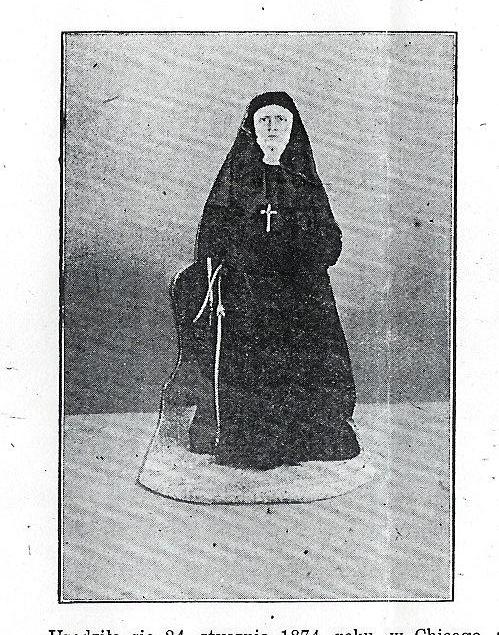
This is the only known photograph of her found in her prayer book.
“Isadore’s Secret” by Mardi Link
Sister Mary Janina was the third child born to Jan and Josephine Mezek. After having two boys, Frank and Emil, the baby girl was named for her mother, Josephine Mezek. They immigrated from Poland to the United States in the late 1800’s. Unfortunately the children were orphaned when Josephine was just nine years old. She was sent to live with the Felician nuns in Detroit. ( I was unable to find records of her older brothers Frank and Emil.) Josephine learned to play the piano and sang well. She was vivacious and energetic. She took her religious vows and the name Sister Mary Janina in 1901 when she was 18 years old. Sister Janina had arrived at Holy Rosary in August of 1906 serving as the leader of the school of two hundred students. At this country school many students would board during the winter months. The families held a strong respect for the education their children were receiving. I marvel at these nuns who came willingly with very little training and did their best.
On that Friday morning, Stella the housekeeper, had baking to tend to and didn’t have patience for needless decorations. Stella often scoffed about Sister Janina to parishioners, “That one is no good as a nun. Her duties go unfinished.” Stella was upset by Dr. Fralick and Father Andrew attending to Sister Janina in her room . . . ALONE. That is NOT allowed for a nun, being alone with a man. It was unheard of in Stella’s eyes. Stella regularly confided her feelings with some ladies in the parish. (“Isadore’s Secret”)
The Search
Sisters Angelina and Josephine couldn’t locate Sister Janina after they rose from their nap. Sister Janina had left her rosary (prayer beads) and her prayer book on her windowsill. She had always carried these items with her.
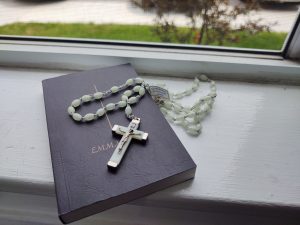
With concern the sisters started the first of many searches for Sister Janina. Sometimes she like to hike in the woods and around the swamp. She loved to sing, too, while she strolled. When Father Andrew and his fishing group returned another more organized search began. Many searches followed. Father Andrew paid for enhanced searches using a bloodhound and a clairvoyant.
The clairvoyant described a home in Glen Lake where she believed Sister was being held. The Empire sheriff searched the house and nothing was found.
A WEEK after Sister Janina’s disappearance, Sheriff Kinnucan joined the search. There was speculation that Sister Janina had left. A strange buggy had been seen in the area on the 23rd.
The Arrest (1918)
After being escorted from Manistee to Leland for questioning, Father Andrew’s fishing excursion freed him from arrest. However, Stella’s lack of alibi and her professed attitude about Sister Janina resulted in her imprisonment. Stanislawa “Stella” Lipczynska was taken to jail in Leland.
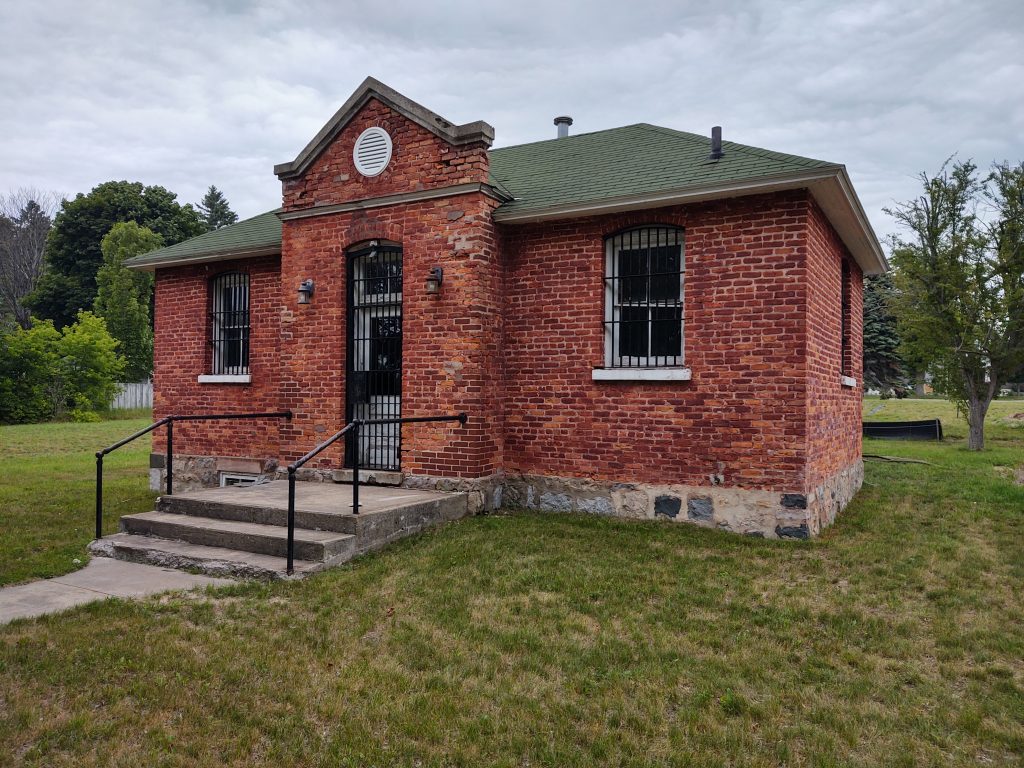
This is the jail where Stella was manipulated and tortured.
Sheriff Kinnucan had confiscated Stella’s rosary which upset her as it was her link to faith. In court Stella reported that the Sheriff Kinnucan asked if she’d like to see Sister Janina? With hope believing that Sister had come back, Stella agreed. Then he brought her to a dark room lit with candles. On the table laid Sister Janina’s bones. Her skull had been hung with the jaw moving. A voice repeated, “You killed me. You killed me.”
A Polish speaking female detective, Mary Tylicka, was put in the cell with Stella posing as an arrested criminal to try to befriend Stella and have her confess. Tylicka submitted the following statement claiming Stella had confessed, “First I stunned her. Then I went out into the garden and got a spade. I dug a hole under the church, dragged the body to the hole and put it in. As I was trying to cover the head, it would always rise up. I threw two or three shovels of dirt on the head, but each time it rose up. Then I took the backside of the spade and knocked the Sister three times on the head with all my might.” (“Isadore’s Secret”)
On May 4th, 1919 Howard Campbell and Peter Glassmire, attorneys from Manistee arrived (after a four hour drive) to prepare Stella’s defense. The clerk informed the attorneys Sheriff Kinnucan and Judge Marin Brown were out of town and the clerk couldn’t give them admittance to their client.
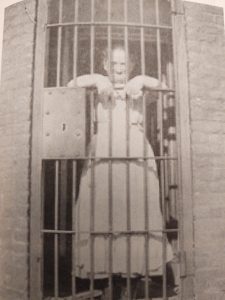
Photo Credit: “Isadore’s Secret” by Mardi Link
The attorneys observed Stella through the barred windows. She was repeating prayers, rolling on the floor, making noised that didn’t sound human. The two demanded that Stella required medical attention. “I assure you that the prisoner is getting all the care and attention necessary” said Mr. Anderson, the clerk.
Stella was sent to Ann Arbor for a psychological evaluation. After two weeks the doctor claimed that Stella had been faking this “insane” behavior and was fit to stand trial.
The Trial
On July 29th, 1919 the Leland courtroom’s 100 seats were filled like cord wood. This included reporters from Chicago and New York as well as statewide representation. Stella’s attorney requested a change of venue, but was denied by the judge. The jury was sequestered in a local motel.
Mary, Stella’s daughter, sobbed throughout the proceedings. She had come back from Milwaukee where she lived with her husband John Flees. John had grown up in Isadore, met Mary and the two had been married in 1910.
Some villagers testified about Stella’s harsh, abrasive personality. In an article by Elizabeth Edwards written in 2001 a local, Michaeline Pleva, who was a young student at the school spoke of Stella, ” Kids kept away from her. They didn’t go to the rectory unless she called for them.” The trial took place when Michaeline Pleva was in eighth grade.
Mary Gatzke, a parishioner, had testified about Stella, “She said the priest was no priest. He was no more than a man with wives. She called Janina a slut.”
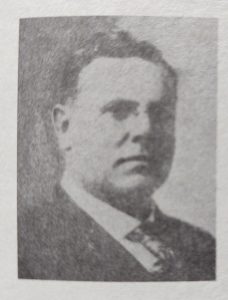
Photo Credit: “Isadore’s Secret” by Mardi Link
A letter arrived saying, “Sister Mary Janina was not abducted or murdered. She was simply tired of her job and slipped quietly away.” It was signed, “Protestant Pup” Handwriting experts were called in and evaluated the writing sample. It was deemed that Dr. Fralick had written the note. Judge Martin Brown didn’t allow the letter into evidence. This evidence clearly demonstrated that Dr. Fralick appeared to be guilty. Many speculated that he had gotten Sister pregnant. He could have botched an abortion resulting in Sister’s death. Perhaps, Dr. Fralick had killed her, buried her on a farm then moved her body to the church basement. However, this suspicion was NEVER brought before the jury resulting in Stella being tried for the death of Sister Janina.
The bones were laid out on a table in the courtroom. Doctors were called to testify evaluating the fracture in the skull. Dr. Fralick ( who cared for Sister Janina behind closed doors) and Dr. Slepica of Suttons Bay claimed the skull fracture was the cause of death. A pathologist from Chicago was called and claimed that the fracture occurred postmortem.
At the trial the Felician Sisters asked the judge if they could have a moment with Sister Janina, after all she never received last rights or a proper service. With a nod from the judge the Sisters encircled the table of bones and recited prayers.
Stella was found guilty of murder and sentenced to life in prison.
Appeal
In 1920 the Michigan Supreme Court reviewed Stella’s case. The letter from the “Protestant Pup” had never been entered into evidence, so the ruling was upheld.
Father Andrew Bieniawski championed Stella. In 1927 Father Andrew appealed to outgoing Governor Alex Groesbeck. The Governor paroled Stella, releasing her. She moved to Milwaukee, where her daughter Mary lived, and became a housekeeper for the Felician order of nuns. Stella died in 1961 at 92 years old.
A Play and A Movie
In 1965 Milan Stitt heard the story about a love affair between a priest and nun and the murdered nun’s bones found in the basement of the church from his wife, Ali, who grew up the northern Michigan. Without ever visiting or researching the rumors, he wrote the play “The Runner Stumbles.” Milan created a fictional account of the story developing conflict by showing the priest’s reverence for a revengeful God while the nun, Sister Rita, viewed our creator as loving. The copy of the script that I was able to obtain had a copyright date of 1971.
In 1976 the play was featured on Broadway for six months at Little Theatre .(currently named the Helen Hayes) The play was presented in Mexico as “Love and Crime in the House of God.” In Germany the title was “Privileged Communication.” In Spain it was called “Beyond Love.”
In 1979 Dick VanDyke starred in the TV movie, “A Runner Stumbles.” This reopened painful wounds for the members of Holy Rosary. It created public interest where those affiliated with the church had moved on and had put their focus on being the “souls of the world.”
I, too, had heard whispering of this story in the 1970’s. We had spent our summers in Lake Leelanau where my mother grew up. I have always been curious about this event. What caught my heart was the people of Isadore and the Holy Rosary Parish. They are devout and genuine in their compassion and commitment to their faith and to each other.
Holy Rosary Parish
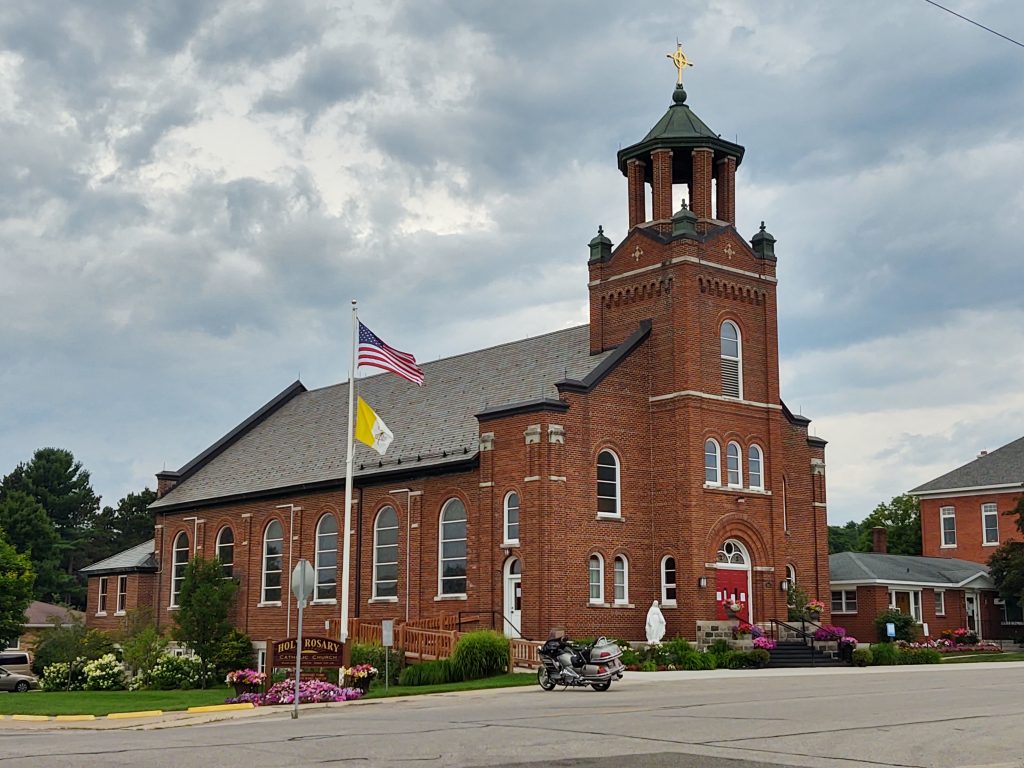
On December 12, 1923 Bishop Kelly blessed the new brick church built on a foundation of field stones. Devoted parishioners had hauled these massive boulders from their farmland on which to raise their church. Atop the hill on the corner of South Shomberg and East Gatzke roads the thirteen stained glass windows caught the sunlight as church members prayed during the blessing.
In Holy Rosary’s history book it is proudly reported that from 1892 to 1999 (when it closed) the school had educated hundreds of children with many students accepting their call for religious life: forty nuns and nine priests. Growing up Roman Catholic, there was an unwritten family “suggestion” that one girl should become a nun and one boy should join the priesthood. My mother came from a family of ten and my father a family of eight. To nurture this unwritten church suggestion several of my aunts and uncles had been sent to Catholic boarding school with the hope of sparking an interest in a commitment to religious life. My six uncles on my mother’s side attended St. Joe’s Seminary in Grand Rapids. My dad’s sister did accept the calling, but later left her order and married. Aunt Genevieve continued to work in the church as a teacher and music director.
In the “Holy Rosary Parish History Book”, Sister Janina’s disappearance is never mentioned. Locals refer to the incident as, “The Tragedy.” My cousins, Mike and Deb (Popa) Bunek are members and on the parish council. I called with questions and they welcomed the idea of me joining them at their parish picnic. Usually Holy Rosary holds a chicken dinner fundraiser and raffle, but with Covid 19, they decided to restrict attendance to parishioners only. The parish council planned a pig roast (two hogs), side dishes and homemade pie, followed by the raffle prize drawing. I was hoping to get a chance to talk with locals about “The Tragedy,” however, I was in for a life lesson I will forever cherish.
Accordian Polka music set a festive tone as I walked up to Holy Rosary Church last weekend (July 26, 2020) Children twirled in the grass. “B – 9”. . . Bingo numbers were being called beneath a nearby tent. I decided to stop inside the church to see the stained glass windows before meeting up with Deb and Mike. I wanted to take some photographs of these uniquely constructed pieces of art created in the early 1900’s.
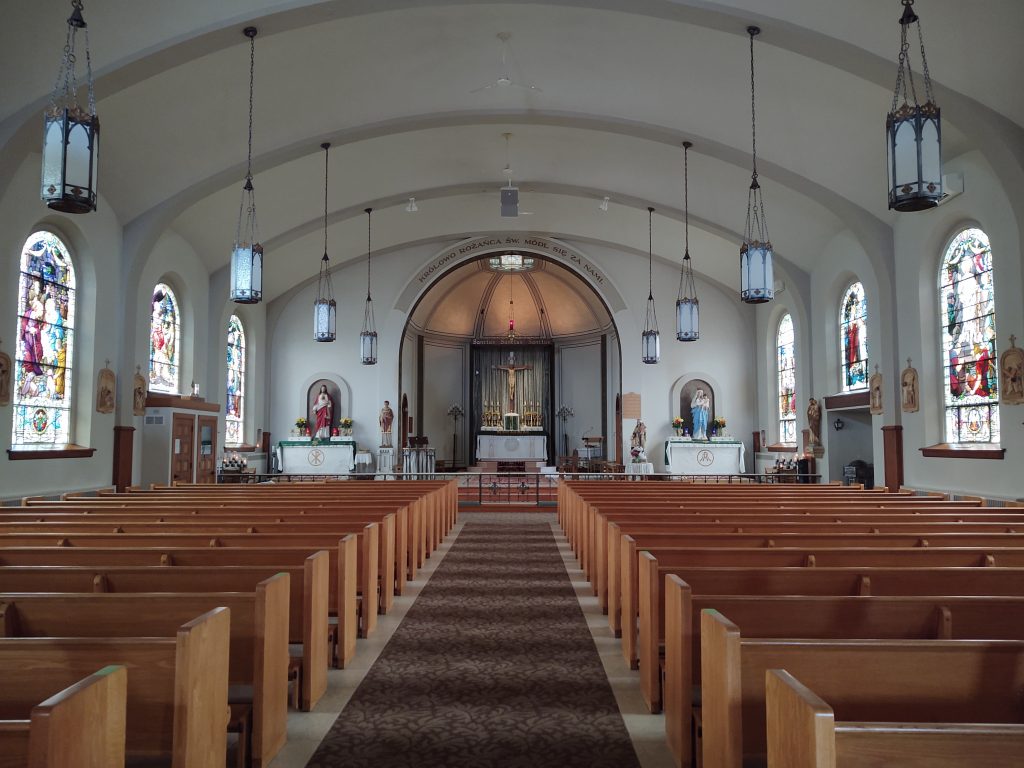
As I opened the door, I saw the priest, Father Donald Libby, facing the altar with his back to the socially distanced congregation. I hadn’t expected mass to be happening. I had been watching outdoor mass on line which was held on their porch. Swallowing my surprise as polka tunes danced in the air, I whispered to the usher, “May I sit down?” He answered with a quick nod. As I moved through the doorway, I realized Father was speaking in Latin. The congregation (30 people) were answering in Latin as well. I slid into a pew in the back. I observed the crowd carefully to know when it was time to stand, sit and kneel. The two altar boys moved in a fluid, synchronized manner as Father prayed, consecrating the bread. Their genuine devotion was entrancing. Goosebumps rose as a woman in the balcony began to sing a hymn in Latin and Father distributed the host (communion bread) to kneeling parishioners along the front of the church. This was a place of pure reverence. As the church members genuflected (going down on one knee and making the sign of the cross with their right hand) and quietly left, I stayed enjoying the atmosphere.
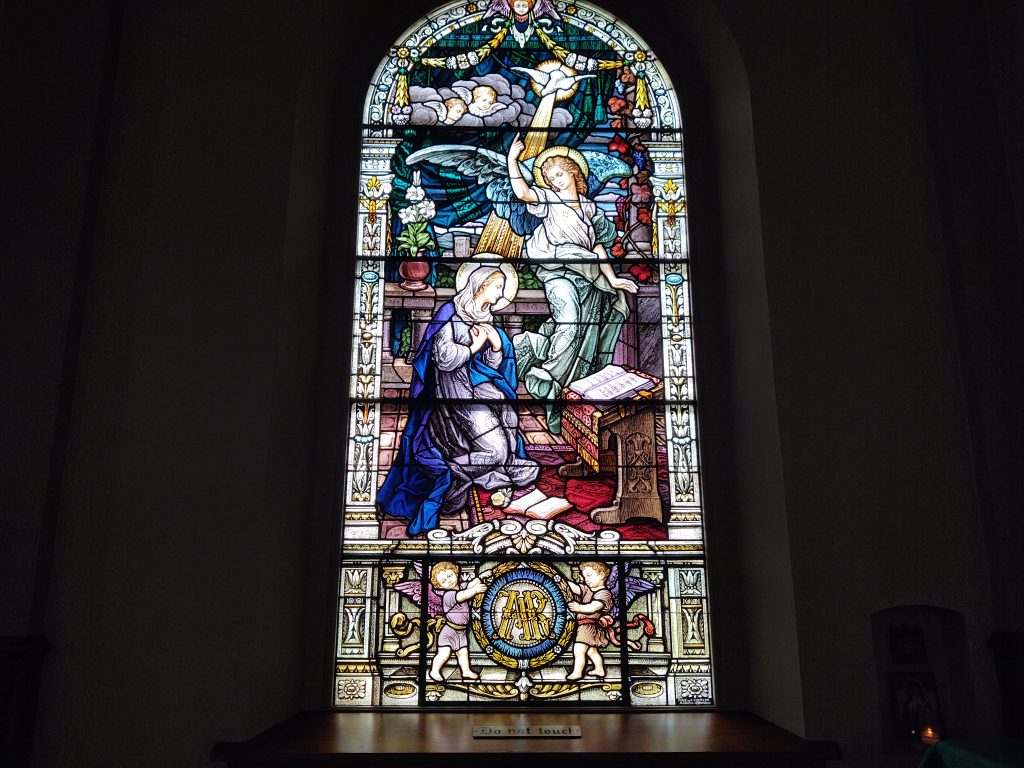
This is one of thirteen stained glass windows.
The stained glass windows are stunning! They show the story of the rosary featuring Mary and Jesus. In ancient Europe, stained glass windows displayed the gospel teachings in a time when many couldn’t read or didn’t have access to books. The windows were not only grand pieces of artwork but also taught the lessons of God’s word.
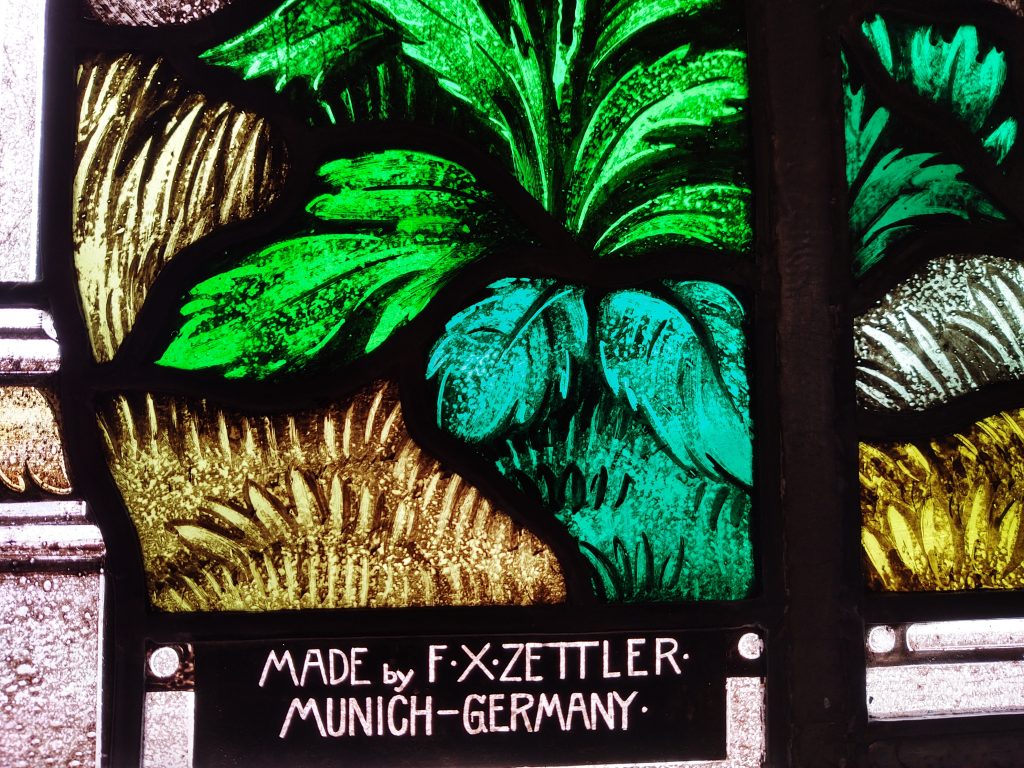
The glass artwork was made by the Royal Bavarian Stained Glass Manufactory in Munich, Germany founded by Franz Xavier Zettler. Instead of using little pieces of colored glass, they started a new method. Artists painted the glass in a Gothic style with shading and perspective then fired the pieces in a kiln. The colors would adhere to the glass. The parish had ordered thirteen windows at $1,500 each. Upon delivery they received $2,500 pieces. There are many rumors why they had gotten an upgrade. Possibly a church in Europe had ordered the windows but was demolished in the war. Another possibility was that the windows had been put in storage from a current church which was demolished during a WWI bombing. These stained glass displays tell their own story.
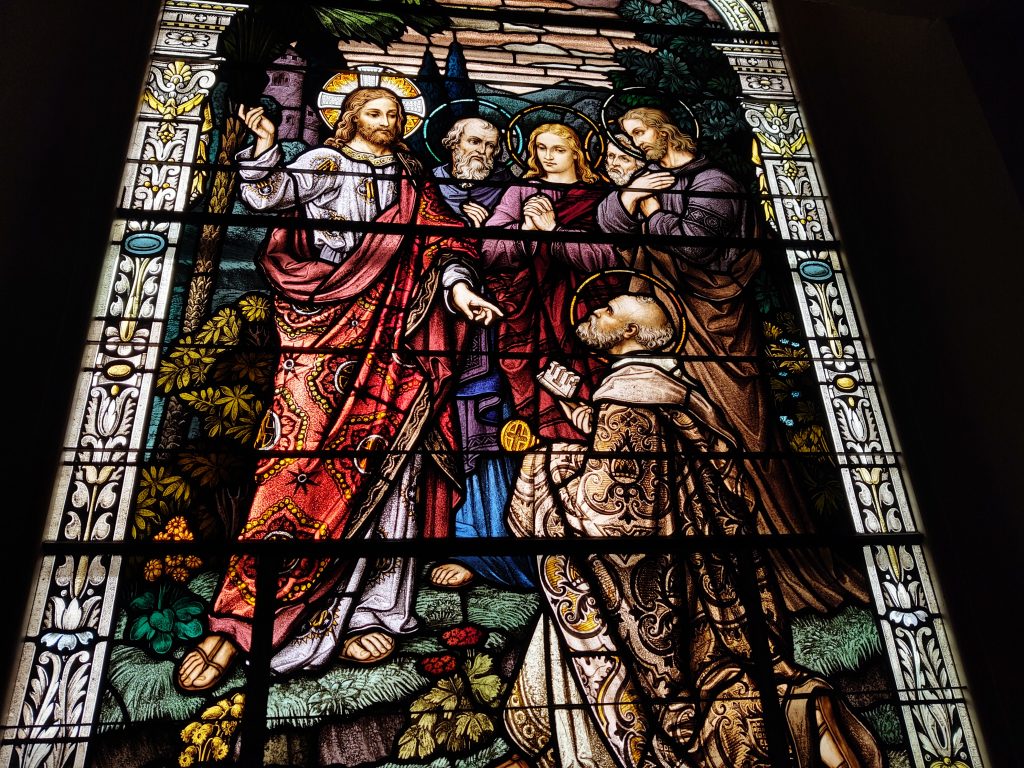
This Gothic technique was developed in the early 1900’s.
I located my cousins Deb and Mike. We caught up on our recent family adventures and reminisced about our numerous and memorable family reunions. Deb shared about her faith. ‘God has given us everything. We need to look at how we can serve Him. It’s not about how I ‘feel’ in church. It’s about what I can do for God.’ So often people focus on themselves and their own needs and wishes instead of looking outward to do for others. It’s a great perspective to put into practice. So, digging up the story of Sister Janina needed to left buried. I needed to be present and look to the future, not dwell in the past.

Cousins and parishioners at Holy Rosary
A white haired, ‘experienced’ lady walked over with her cane. Deb introduced Eunice Lamie. “You can remember my name by saying, ‘You Nice.'” She pointed out. I quickly learned that she knew my mother, Marcia, and the Bunek siblings. She and my grandparents shared relatives on the French side. Best yet, she remembered my grandmother, Martha, and loved that I was named after her.
As Father Libby walked by, Deb offered to introduce me. When we caught up to him I complimented him on his genuine devotion and leadership. I appreciated being part of the mass in Latin. It had been awe inspiring. I explained that I’d been watching mass on line and have enjoyed his photos from his trips to Rome.
Father Donald Libby grew up in the Grand Rapids area (Northview Wildcats) attending the Methodist church with his family. He openly shared that when he was eighteen, his mother passed and he started to search for meaning. He attended Catholic mass (with his girlfriend) and was struck by the intensity of the consecration. (The sacrament of turning the bread and wine into Christ’s body and blood.) He knew he needed to be a priest.
In a “MyNorth” article in 2015, Father Libby recalled how he had been asked to serve Christmas Eve mass at Holy Rosary in 2007. He had said that his eyes were drawn the windows especially the nativity scene. (Mary and Joseph holding baby Jesus) In 2009 Father Libby was assigned to Holy Rosary which he said was a dream come true. With a smile and a hop in his step, Father was off to work retrieving items for the picnic.
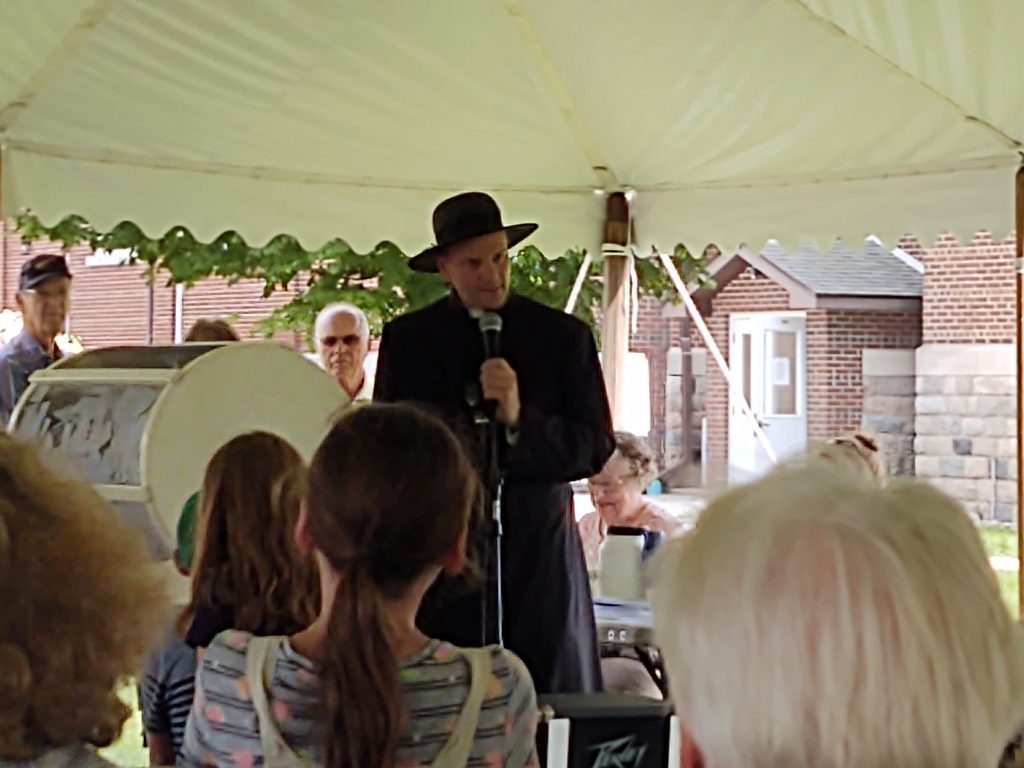
At the end of the picnic everyone pitched in to clean up, young and old alike. Then, it was time for the raffle drawing of thirty-four items including monetary donations in memory of former members. Many familiar names were called out by Father Libby: Pleva, Peplinski, Popa, Mikowski and Fleis. (In the book by Mardi Link, it was spelled, “Flees.” )
Institutions, such as the Roman Catholic Church, have often struggled as they cope with the choices of a few individuals, while the majority of people are hard working and dedicated. Years ago, it was common practice for these issues (murder and unwed pregnancy) to be dealt with quietly, unlike today where our culture goes in the complete opposite direction using social media.
Sister Mary Janina’s murder and the tactics used to have Stella found guilty as well as Father Edward’s acts causing a teenage pregnancy are despicable and deserving of punishment. Focusing on the negative only produces negativity. Where putting one’s emphasis on the positive can be lifting. As Deb says, “God has given us everything. We need to be thinking about what we can do for Him.”
The people of Holy Rosary are authentic and devoted. The church is bustling with a faithful and steadfast community. Life is about moving forward and making the future the best it can be by using the tools God has given us.
Sources:
“Isadore’s Secret Sin, Murder and Confession in a Northern Michigan Town” by Mardi Link 2009 – available on Amazon
“The Runner Stumbles A Play in Two Acts” by Milan Stitt 1971 – available on Amazon
“Sometimes . . . The Runner Stumbles” by Ernest Gold audio book – available on Amazon
MyNorth article “Isadore’s Secret of the Missing Sister”
by Elizabeth Edwards 2001
“The Errant Nun” by Harry Milostan – available on Amazon
MyNorth article “World Class Stained Glass in Leelanau Church”
by Jeff Smith 2015
Find a grave. com
Holy Rosary’s Bulletin July 12, 2020, their online site and email
Mike and Deb Bunek, cousins and parishioners






One thought on “A Murdered Nun in Michigan”
Please contact me.